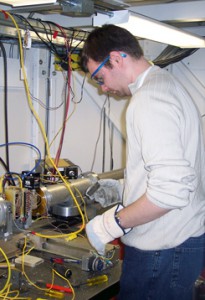The Carbon Mineral Challenge

Daniel Hummer (Southern Illinois University) preparing equipment at one of the beamlines at the Stanford Synchrotron Radiation Lightsource, SSRL (in Menlo Park, California, USA) to conduct an experiment crystallizing titanium oxide minerals. Credit: Dan Hummer
A worldwide hunt for new carbon minerals
In 2015 researchers at the Carnegie Institution for Science and the University of Arizona used statistical models to predict that at least 145 of Earth’s carbon-bearing minerals remained undiscovered. The Carbon Mineral Challenge is an effort to mobilize amateur and experienced collectors alike to help us find those missing minerals.
Robert Hazen, Robert Downs, and Daniel Hummer led the research. Hummer (pictured at right) continues to oversee the operation of the Carbon Mineral Challenge.
Why carbon minerals?
Carbon is one of the most chemically diverse elements, and occurs in compounds with almost every element of the periodic table. Most importantly, without carbon there is no life on Earth. Life has interacted with rocks over billions of years, generating a telltale geobiological footprint. “Mineral evolution” refers to the study of the dramatic changes in near-surface mineralogy over the course of Earth history. A central theme of mineral evolution is that life and minerals have co-evolved.
How the Carbon Mineral Challenge Works
Amateur and professional mineral collectors should follow the procedures outlined by the International Mineralogical Association Commission on New Minerals, Nomenclature and Classification. Once the commission has approved the new mineral, the team responsible for its discovery and verification should submit their entry via the contact form on mineralchallenge.net. Interested collectors may contact Carbon Mineral Challenge International Advisory Board members in their region with questions about mineral analysis and verification. There are useful links, a table of known carbon minerals, and a list of FAQs for potential participants throughout this Website.
The Carbon Mineral Challenge will continue until September 2019. The Deep Carbon Observatory, sponsor of the Challenge, will publicly recognize each discovery as it happens and celebrate the final suite of newly discovered carbon minerals at the culmination of its decadal program in late 2019.
Where should I start looking for new carbon minerals?
While there is no treasure map for finding the missing carbon minerals, there are some potentially rewarding localities to consider.
Where is this research taking us?
Carbon mineral evolution is providing a fresh perspective of Earth’s history by addressing suites of new questions. The answers to these questions may profoundly influence Earth materials research and education by telling the story of Earth in a new and exciting way.
- What were the earliest carbon-bearing minerals on Earth?
- Did carbon-bearing minerals play a role in the origin of life?
- How did the evolution of life affect the evolution of carbon minerals (and vice versa)?
- Are there carbon-bearing minerals on the Moon and Mars?
- Are humans affecting the diversity and distribution of carbon-bearing minerals?
Some Carbon Mineral Facts
- Research suggests at least 548 carbon minerals exist on Earth. Not all of those have been found.
- Minerals can be hard to locate. Some might change in adverse conditions, and others can be as small as specks of dust.
- Verified in 2015, tinnunculite forms when hot gases from burning carbon react with the excrement of a falcon.
- Diamond, a carbon mineral, is actually much more common than most carbon minerals.
- Ewingite, discovered in 2016, is currently the most structurally complex mineral known.
- Undiscovered carbon minerals could incorporate organic molecules.
- New carbon minerals may be found around evaporated saline lakes, coal mine fires, and volcanic fumaroles.
- A new carbon mineral could be sitting unanalyzed in a museum collection drawer.
- New minerals require the approval of an international body called the Commission of New Minerals Nomenclature and Classification (CNMNC).

